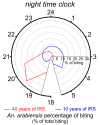Implications of Sublethal Insecticide Exposure and the Development of Resistance on Mosquito Physiology, Behavior, and Pathogen Transmission
- PMID: 34680686
- PMCID: PMC8539869
- DOI: 10.3390/insects12100917
Implications of Sublethal Insecticide Exposure and the Development of Resistance on Mosquito Physiology, Behavior, and Pathogen Transmission
Abstract
For many decades, insecticides have been used to control mosquito populations in their larval and adult stages. Although changes in the population genetics, physiology, and behavior of mosquitoes exposed to lethal and sublethal doses of insecticides are expected, the relationships between these changes and their abilities to transmit pathogens remain unclear. Thus, we conducted a comprehensive review on the sublethal effects of insecticides and their contributions to insecticide resistance in mosquitoes, with the main focus on pyrethroids. We discuss the direct and acute effects of sublethal concentrations on individuals and populations, the changes in population genetics caused by the selection for resistance after insecticide exposure, and the major mechanisms underlying such resistance. Sublethal exposures negatively impact the individual's performance by affecting their physiology and behavior and leaving them at a disadvantage when compared to unexposed organisms. How these sublethal effects could change mosquito population sizes and diversity so that pathogen transmission risks can be affected is less clear. Furthermore, despite the beneficial and acute aspects of lethality, exposure to higher insecticide concentrations clearly impacts the population genetics by selecting resistant individuals, which may bring further and complex interactions for mosquitoes, vertebrate hosts, and pathogens. Finally, we raise several hypotheses concerning how the here revised impacts of insecticides on mosquitoes could interplay with vector-mediated pathogens' transmission.
Keywords: host-seeking behavior; insecticide exposure; insecticide resistance; mosquito; pathogen transmission.
Conflict of interest statement
The authors declare no conflict of interest. The funders had no role in the writing of the manuscript, or in the decision to publish the results.
Figures



References
-
- WHO . Fact-Sheets: Dengue and Severe Dengue 19 May 2021. WHO; Geneva, Switzerland: 2021.
-
- WHO . World Malaria Report 2020: 20 Years of Global Progress and Challenges. WHO; Geneva, Switzerland: 2020.
-
- WHO . Global Strategy for Dengue Prevention and Control 2012–2020. WHO; Geneva, Switzerland: 2012.
-
- Chouin-Carneiro T., Vega-Rua A., Vazeille M., Yebakima A., Girod R., Goindin D., Dupont-Rouzeyrol M., Lourenço-de-Oliveira R., Failloux A.-B. Differential susceptibilities of Aedes aegypti and Aedes albopictus from the Americas to Zika virus. PLoS Negl. Trop. Dis. 2016;10:e0004543. doi: 10.1371/journal.pntd.0004543. - DOI - PMC - PubMed
Publication types
Grants and funding
LinkOut - more resources
Full Text Sources

